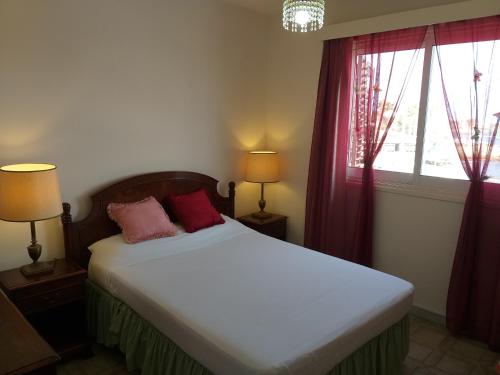World Heritage Site, Pafos, Cyprus
Where does Aphrodite, the Greek Goddess of Love, come from?
Does she come from here in Pafos on the island of Cyprus? Or does she come from the imagination of an ancient poet?
It really depends on how you look at it.
Kouklia
It was in the village of Kouklia that the Cult of Aphrodite formed thousands of years ago. They used an enormous stone temple built by the Mycenaeans as the focus of their worship and it was here that the idea of Aphrodite first rose from the minds of men.
But it is extremely unlikely that she was the deity of romance that we know today – or anything even close, for that matter.
Firstly, the goddess they worshipped was probably originally more of a general deity – a protector of Cyprus who blessed the things important to the population here (which at this point was copper and trade).
Secondly, the goddess probably didn’t have a particular form to begin with. In fact, this large piece of black basalt on display in the museum at Kouklia is one of the early symbols of worship. It’s not particularly sexy, is it?
To understand the origin of Aphrodite you need to look at the female figurines that are littered through the history of the island – on display in museums everywhere – to realise that the idea of a deity in the form of a woman existed and was constantly developing before the word ‘Aphrodite’ ever reached anyone’s lips.
Kato Pafos Archaeological Park
In the 4th century BC, the ancient city of this region of Cyprus was moved from Kouklia to modern day Pafos.
This was mainly for commercial and political reasons – this was a strategic stop on the trading route between Egypt and Greece and Rome and the harbour in this new location was much better.
But it also falls around the same Hellenic period that we see a shift in the cultural appreciation of Aphrodite.
The Goddess of Love had taken on a new form after being featured by famous Greek poets like Hesiod and Homer. Although they give her different mythical origin stories, there is a consistent representation in their literature.
Aphrodite is now a beautiful woman who emerged in Cyprus and is a symbol of pleasure and procreation.
Although worship of Aphrodite continued at the original sanctuary and the site became somewhat of a pilgrimage destination, when the Romans arrived in Cyprus they expanded the new Kato Pafos into the magnificent city that still has its remains on the site today.
A large theatre and baths can be seen, as well as the foundations of large houses of the powerful.
These houses are particularly significant because the wealthy owners installed detailed and vibrant mosaics on the floor. They showed scenes from legends, of history, and daily life. Many of them have been well preserved, even 2000 years later, and you can walk around and see them for yourself.
A team of archaeologists are still working here on the site to restore and protect these mosaics. Some are permanently uncovered and are inside buildings erected to protect them. Others are out in the sun and you may even see people working on them when you visit.
Tombs of the Kings
Both of the locations at Kouklia and the Kato Pafos Archaeological Park are part of a World Heritage Site – recognised because of the significant link to Aphrodite and because of the quality of the ruins here. The other main area that is included in the site is the Tombs of the Kings.
This incredible necropolis is just a short drive from the centre of Pafos and it’s where the wealthy and powerful from the city were buried from the 4th century BC. The tombs were built underground and were designed to look like houses, with columns and frescoes and other decorations.
Quite a few of them are still in good condition and you can climb down inside and look around. It’s slightly creepy to think about all the bodies that were laid to rest here thousands of years ago in such opulent settings.
Aphrodite as Venus
As the Romans took control of Cyprus (from the first century BC) and the rest of Europe, the idea of Aphrodite evolved into Venus, the Roman name for the Goddess of Love. From this point, her story becomes much more focused and very similar to what we think of today.
The Roman mythology gives her a different origin but she represents the same ideals of love, sex and pleasure. And physically she is almost identical as a beautiful young woman – a long way from that black basalt rock.
Here is where it all comes full circle, back to Cyprus and to Pafos specifically. Because in the centuries to come – through the Renaissance and to today – we see the imagery of Venus as a deity arriving from the water on a sea shell. (Think of Botticelli’s The Birth of Venus as the best example.)
This is the story taken from the Greek mythology, which says that Aphrodite was born from the foam of the sea that was caused when Kronos castrated his father Uranus and threw his genitals into the water. (The name ‘Aphrodite’ literally means ‘risen from the foam’.)
And this Greek mythology was based on the idea of a female deity that emerged in Cyprus even earlier, represented by figurines and stones.
This is the centre of it all – Pafos, where the Cult of Aphrodite gave birth to one of the world’s most enduring symbols of love.
The World Heritage Site may now seem in many ways like an archaeological site but the stories behind it – what they represent, what they have meant to people for millennia – are so very powerful, even today.
THE BEST ACCOMMODATION IN PAFOS
Pafos is a very popular beach resort city so there are lots of hotels and other accommodation options to choose from.
BACKPACKER

If you’re looking for a budget option, 777 Beach Guesthouse has basic dorm beds available.
BUDGET

A very reasonably-priced option with good space is Valentino’s Court.
BOUTIQUE
LUXURY
And the nearby Almyra is a beautiful design hotel by the beach.
Time Travel Turtle was supported by the Cyprus Tourism Organisation but the opinions, over-written descriptions and bad jokes are his own.
This is so informative. Simply loved the read. Wish to visit and explore this amazingly beautiful place someday. Thanks a ton for sharing mate.
The power of poets!